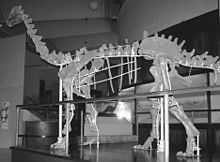Neuquensaurus
| Neuquensaurus Temporal range: Late Cretaceous | |
|---|---|
 | |
| Holotypic caudal vertebrae | |
| Scientific classification | |
| Kingdom: | Animalia |
| Phylum: | Chordata |
| Clade: | Dinosauria |
| Suborder: | †Sauropodomorpha |
| Clade: | †Titanosauria |
| Family: | †Saltasauridae |
| Subfamily: | †Saltasaurinae |
| Genus: | †Neuquensaurus Powell, 1992 |
| Species | |
| |
| Synonyms | |
|
Genus synonymy
Species synonymy
| |

Neuquensaurus (meaning "Neuquén lizard") is a genus of saltasaurid sauropod dinosaur that appeared in the Late Cretaceous, 71 million years ago in Argentina and Uruguay in South America. Its fossils were recovered from outcrops of the Anacleto Formation around Cinco Saltos, near the Neuquén river from which its name is derived.

This dinosaur is believed to have possessed armor-like osteoderms. It is related to Saltasaurus.[1] A relatively small sauropod, it is one of the most completely known of Patagonian sauropods. In addition to the original fossils described by Lydekker in 1893, it is represented by fossils collected in the early twentieth century, and more recent material, including a well preserved and partially articulated specimen described in 2005(with two associated osteoderms),[2] as well as additional undescribed material.
A mounted skeleton is displayed at the Museo de la Plata.
References
- ↑ Alejandro Otero (2010). "The appendicular skeleton of Neuquensaurus, a Late Cretaceous saltasaurine sauropod from Patagonia, Argentina". Acta Palaeontologica Polonica 55 (3): 399–426. doi:10.4202/app.2009.0099.
- ↑ A New Specimen of Neuquensaurus australis, a Late Cretaceous Saltasaurine Titanosaur from North PatagoniaLeonardo Salgado, Sebastián Apesteguía and Susana E. HerediaJournal of Vertebrate PaleontologyVol. 25, No. 3 (Sep. 30, 2005), pp. 623-634
Powell, J.E. (1992). "Osteologia de Saltasaurus loricatus (Sauropoda - Titanosauridae) del Cretacico Superior del noroeste Argentino" In: J.L. Sanz and A.D. Buscalioni (editors), Los Dinosaurios y Su Entorno Biotico: Actas del Segundo Curso de Paleontologia in Cuenca. Institutio Juan de Valdes 165-230.